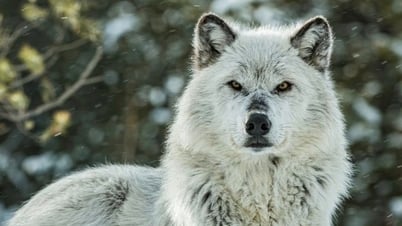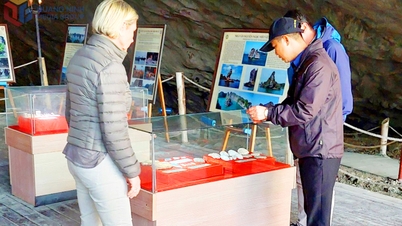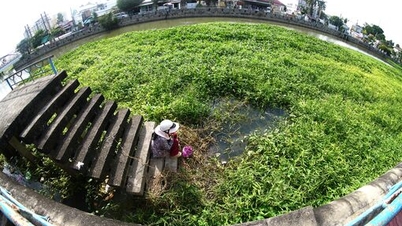The moment that made scientists "freeze" about wild wolves.
Shocking footage has just been released in Canada, recording wild gray wolves may have developed tool-using behavior - an ability previously only recorded in chimpanzees, crows and some other primates.
New research has released images showing two gray wolves approaching and pulling on the crab trap to retrieve the food inside, which included herring and sea lions.
The traps were deployed by the Haíɫzaqv indigenous community from 2023 to exploit food sources and at the same time control the invasion of European green crabs - a harmful alien species in the waters near Bella Bella.
Initially, scientists believed that the traps were damaged by marine animals such as otters or seals, especially since many of the traps were completely submerged. However, that changed when researchers from the Haíɫzaqv Wolf Project reviewed surveillance video footage.
Complex and goal-oriented behavior
The videos show a female wolf swimming out to a submerged crab trap buoy. The animal bites the buoy, pulls on the rope, and brings the entire trap system to shore in a single, purposeful movement.
As soon as the trap emerged from the water, the wolf immediately approached the bait compartment and ate the contents clean.

We may have underestimated the intelligence of wolves, which are known mainly for their pack behavior and efficient hunting strategies (Photo: Getty).
According to the research team, this sequence of behaviors shows a level of causal cognition, or the ability to grasp the connections between the components of a tool without seeing the entire structure.
They emphasize that this is “multi-step, goal-oriented, and persistent behavior,” far beyond normal natural hunting behavior.
Controversy over the definition of "using tools"
The central question, though, remains: does this behavior qualify as tool use? By the classical definition in behavioral biology, animals must create or adapt tools to manipulate their environment. In this case, the wolves did not create their own crab traps, but merely interacted with pre-existing structures.
However, the researchers argue that the complexity of the string-pulling operation deserves to be considered a form of exotic tool, similar to the way humans use computers, phones, electronic devices... even though they do not fully understand the internal operating mechanisms.
In another video, the researchers also recorded a wolf pulling on a crab trap while it was partially floating on water. While not as complete as the previous video, this recording reinforces the theory that the behavior is not random, but may be a skill that has spread through the population.
The big question is: Do they learn by watching humans, or by some other means?
Re-evaluating wolf intelligence

A wolf pulls a crab trap to eat the bait inside (Photo: Research team).
Animal behavior experts say the discovery could prompt a rethinking of the intellectual abilities of wolves, which are known primarily for their pack behavior and efficient hunting strategies.
If “trap-pulling” behavior is confirmed as tool use, gray wolves would join a very narrow list of animals that possess the ability to purposefully manipulate objects, a trait that has been important in cognitive evolution.
Although controversial, the authors say the discovery is evidence of the exceptional intelligence of wild wolves.
"Just like we type lines of text on a computer without fully understanding its internal structure, the ability to use an object without knowing how it was made still demonstrates a high level of cognition," the authors emphasized.
Source: https://dantri.com.vn/khoa-hoc/soi-hoang-gay-chan-dong-gioi-khoa-hoc-voi-hanh-vi-dung-cong-cu-20251119070658635.htm


![[Photo] Prime Minister Pham Minh Chinh receives Governor of Gunma Prefecture (Japan) and Special Advisor to the Japan-Vietnam Friendship Parliamentary Alliance](/_next/image?url=https%3A%2F%2Fvphoto.vietnam.vn%2Fthumb%2F1200x675%2Fvietnam%2Fresource%2FIMAGE%2F2025%2F11%2F25%2F1764066321008_dsc-1312-jpg.webp&w=3840&q=75)


































![[Photo] Close-up of Ba Ha River Hydropower Plant operating to regulate water to downstream](/_next/image?url=https%3A%2F%2Fvphoto.vietnam.vn%2Fthumb%2F1200x675%2Fvietnam%2Fresource%2FIMAGE%2F2025%2F11%2F25%2F1764059721084_image-6486-jpg.webp&w=3840&q=75)








































































Comment (0)